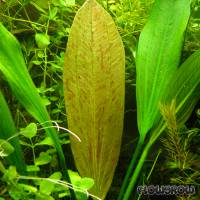



The name Echinodorus grandiflorus is ambiguous - depending on the author it can mean different plants. In the hobby and in aquarium trade, E. grandiflorus usually refers to Echinodorus floribundus. The species described here is E. grandiflorus according to Lehtonen (2008). It is hardly known as aquarium plant any more and practically never found in trade. The true E. argentinensis and E. floridanus also belong to this species.
In the trade, we often find a plant denominated "Echinodorus argentinensis", however, it has nothing to do with E. grandiflorus but is related to Echinodorus palaefolius and E. subalatus.
E. grandiflorus typically originates from rivers and riverbanks along the coast of southeastern South America (southern Brasil, Uruguay, Argentine) and is especially common in river deltas. The southernmost population is found in Argentine in Rio Negro Province, which makes E. grandiflorus the Echinodorus species farthest in the south besides E. berteroi.
One population of E. grandiflorus discovered in northwestern Florida was first described as a species of its own (E. floridanus); this population probably came into being as cultivated plants were introduced into nature there.
In the south of South America, hybrids of E. grandiflorus and the closely related species E. longiscapus and E. floribundus can be found.
The emersed form of Echinodorus grandiflorus is a robust bog plant that grows over a metre in height, with a thick, creeping rhizome, long, round leaf stalks, often with tubercles and oblong-ovate to slightly heart-shaped leathery leaf blades.
This species differs from E. floribundus amongst other differences by the pellucid markings in the leaves, which form lines and dots in E. grandiflorus and only dots in E. floribundus.
Even though growing very large and robust as emersed plant, E. grandiflorus may be cultivated submersed in the aquarium permanently. There it is a rather slow grower, but can reach over 50 cm in height given that it is provided with sufficient nutrients, which makes it suitable for rather large tanks. A substrate rich in nutrients is of advantage. The coarse submersed leaves on their long stalks are lanceaolate to obovate. Young leaves are often of a reddish-golden hue and have reddish-brown freckles. Tiny bristles grow in their rims, which give them a coarse feel.
Their native region lies deep in the south, where winters may be rather cool, which is the reason why this plant tolerates deeper temperaturs.
The land form forms flower stalks, most frequently after a cool period and under short day conditions. The ramifying flower stalks are upright and tower above the leaves. The flowers are rather large, with 3.5 cm, and have up to approximately 30 stamina, wide, overlapping petals and a faint scent.
The formation of adventitious plants on the flower stalks probably varies from population to population; it seems to be missing altogether in the variety known from northwestern Florida (E. "floridanus"). E. grandiflorus can be propagated either by sowing the seeds or by parting the thick, hard rhizome - for large specimens grown emersed you may need an axe or a spade to do so.
E. grandiflorus is rarely found in the hobby, however, it makes a great solitary plant for large, unheated aquaria. Even though the plant grows quite large it does not look bulky as its high-growing rosette consisting of few leaves on long stalks is not very compact.
E. grandiflorus can be cultivated emersed in open tanks. During the warm season it is also great as marsh plant on the edge of outdoor tanks, however, there it needs a substrate rich in nutrients, the most recommendable is loam. It should be hibernated in a cool, frost-free environment in order to induce it to flower in the following summer.
<a href="https://www.flowgrow.de/db/aquaticplants/echinodorus-grandiflorus" target="_blank"><img alt="Echinodorus grandiflorus" title="Echinodorus grandiflorus" src="https://www.flowgrow.de/db/widget/aquaticplants/echinodorus-grandiflorus" /></a>
[url=https://www.flowgrow.de/db/aquaticplants/echinodorus-grandiflorus][img]https://www.flowgrow.de/db/widget/aquaticplants/echinodorus-grandiflorus[/img][/url]
[widget=aquaticplants/echinodorus-grandiflorus]Echinodorus grandiflorus[/widget]